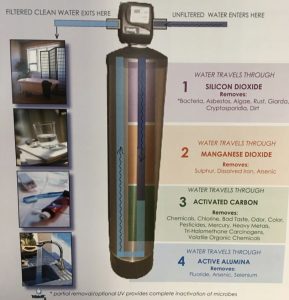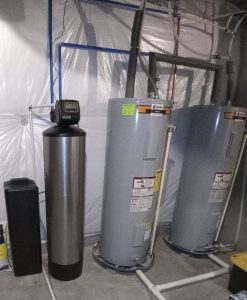
10 Feb Reconsidering Reverse Osmosis
© Natural Interiors®
Almost everyone who drinks or bathes in water from a public source knows that a water-filtration system makes sense for removing micro-plastics and toxic substances, along with intentional additives that include chlorine and fluoride.
Recent studies have shown that micro-plastics are a common find in bottled water — in both plastic and glass bottles. And the safety of additives like chlorine and fluoride, on top of pollution from chemicals and heavy metals, has been discussed and debated for decades.
The most visible companies known for whole-home water softening, have long offered whole-home and under-sink, reverse-osmosis (RO) systems to remove contaminants. Multiple companies have followed suit and produced additional “solutions” that include faucet and shower-head filters, and filtering countertop pitchers and carafes. These items are being purchased in droves.
What we haven’t been publicly told is that reverse osmosis removes more than 14 minerals that water is supposed to contain and leaves the water acidic, or with a low pH. To raise the pH, a tank containing salt pellets is added to “soften” the water in a series of chemical reactions that replace the water’s calcium ions with sodium ions.
Demineralization concerns span decades
Some RO manufacturers also have added a remineralization step to their processes, which adds back healthful minerals. But opponents argue that it is highly difficult to replicate balanced, pure water this way.
Many experts have raised and continue to raise questions about the health effects of drinking “demineralized” water. And while RO is widespread and trusted, its use is unnecessary when there’s a more natural process — first discovered in 1827 — that removes chemicals, bacteria, heavy metals and micro-plastics, in addition to returning the water to its mostly natural state. This includes the correct balance of calcium, potassium, magnesium and other minerals.
For those who know history

The WateRx Process
Ceramic water filtration was first discovered by potter and inventor Henry Doulton, in 1827. Doulton found that filtering water through the tiny pores on a ceramic surface removed pathogens, including cholera. He was commissioned by Queen Victoria to create gravity-fed water filters, housed in his handmade ceramic carafes.
Today, this technology has been reinvented with upgrades. WateRx ceramic-carbon-resin filtration system in 1984. It removes 99.99 percent of the contaminants. These salt-free filtration systems leave the healthy minerals in your drinking water, while removing damaging microbes, chemicals and micro-plastics.
While the whole-home and under-sink tanks look much the same, this technology differs greatly from reverse osmosis. RO forces water through a semi-permeable membrane, removing contaminants, stripping the water of its natural mineral content and lowering its pH.
Studies raise questions
“Most of these mineral components are physically larger than water molecules and are trapped by the semi-permeable membrane of RO filters when drinking water is filtered through it,” according to a 2023 study published on the National Institute of Health’s (NIH) website. “The resultant water is of very poor mineral content, and studies have shown that this water, when consumed, can absorb minerals from the body and eliminate the same.”
This leads to demineralized of the bones and teeth, osteoporosis and cavities, the study concluded. It called for a system that remineralizes the water, which manufacturers have added but opponents don’t trust.
A 2016 study found Vitamin B-12 deficiency was associated with drinking RO water in Western India. This deficiency can cause problems with liver, brain and central nervous system function.
A 2014 article, also published on the NIH website, concluded that oversight and regulations were needed for RO facilities, and consumers needed to be educated.
“Recent studies also suggest that the intake of soft water, i.e. water low in calcium, may be associated with higher risk of fracture in children, certain neurodegenerative diseases, pre-term birth and low weight at birth and some types of cancer,” according to this report. “In addition to an increased risk of sudden death, the intake of water low in magnesium seems to be associated with a higher risk of motor neuronal disease, pregnancy disorders (so-called preeclampsia) and some types of cancer.”
Restoring water like it’s done in nature
In stark contrast to forcing water through a membrane, the WateRx system sends the water through layers of natural media — including silicon dioxide and activated carbon — specifically designed to remove dangers and returning the water to it’s natural, mineral-balanced state. If a customer wants to increase the pH with a salt tank they can, but it is not needed.
It works much in the same way as soil and plants filter rainwater and runoff as it absorbs into the ground, headed for the water table.

WateRx tank on left
Filters might be falling short
The water’s prolonged contact with the media layers is key in removing hazards, which calls into question the effectiveness of faucet filters that have brief contact with the water once the faucet is turned on. And when the filters work, how long do they really last before they are filled with contaminants?
Confusing the picture more are filters that use electrolysis to separate water’s acidic and alkaline components and produce alkaline, or high pH water. The manufacturer promises that this will improve hydration by penetrating cells in the body faster. But what if the water that is being put through the electrodes hasn’t been treated first to remove impurities? Do those penetrate the cells more quickly, too?
There are few definitive answers.
Talk to us before you choose
That is not the case when you speak to a WateRx representative, who will discuss your concerns with you at length and provide data, including third-party test results, attesting to the system’s effectiveness.
Depending on the amount of water treated daily, WateRx tanks generally need to be replaced every one to four years. The cost to install the basic whole-home system is $750, while the under-sink system is $150 to $200.
To speak with the technician in charge of your region, submit a contact form here or call Natural Interiors® at (513) 200-9471. For a $25 discount, use PROMO CODE NI2025 when speaking with the technician.©


No Comments